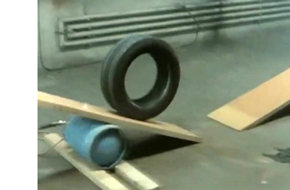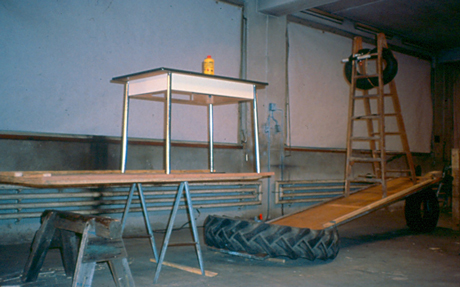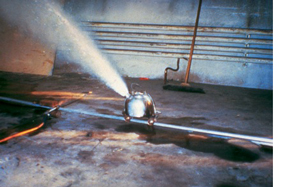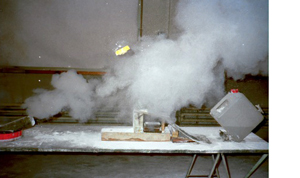|
|
Reviewed by Glenn Erickson
The concept for this show at first doesn't sound particularly impressive. We've all seen attempts at making real-life Rube Goldberg devices. Things roll, spin, tilt, pop and sometimes catch fire, and the result can be amusing. But it's not all that extraordinary. Turner Classic Movies used a computer animated (I think) Rube Goldberg sequence for a movie intro for a number of years.
 What looks like a lot of hard work is in general not much more respected than those gigantic domino-toppling exhibits, as when an entire gymnasium is covered with dominoes that fall in rows. Even when the exhibits approach a Busby Berkeley scale of organization, it's still just dominoes falling. The movie Broadcast News uses a news piece on a domino fall as an example of dumb, empty programming that panders to a news audience that won't sit still for anything meaningful.
What looks like a lot of hard work is in general not much more respected than those gigantic domino-toppling exhibits, as when an entire gymnasium is covered with dominoes that fall in rows. Even when the exhibits approach a Busby Berkeley scale of organization, it's still just dominoes falling. The movie Broadcast News uses a news piece on a domino fall as an example of dumb, empty programming that panders to a news audience that won't sit still for anything meaningful.
Enter Peter Fischli and David Weiss, conceptual artists from Switzerland and collaborators on crazy 'sequencing' exhibitions. Getting together in 1979, their first works were sculptures and films. In 1987's The Way Things Go (Der Lauf der Dinge) their genius really takes off. The basic Rube Goldberg device is a mechanical sequence of actions that form a chain of self-generated motion and change. Instead of balanced dominoes, this 30-minute movie gives us the action of a seemingly endless set of mechanical cause & effect actions. Things roll, fall, blow, slide, flow, rise, catch fire, explode, tip off balance, dissolve, and simmer in chemical reactions. Without human agency, the carefully initiated gimmicks move under their own accord. It's fascinating

to watch. We not only recognize the difficult research and trial & error that were required to make it all happen, it's funny, too. Oddly chosen items are used in ways contrary to their normal function, adding a surreal touch. Some of it looks dangerous. Most of the constructions seem so precarious, we're surprised that the 'links' in the causal chain go off so perfectly.

The exhibition stimulates the imagination. We realize that certain chemicals are simply combustible; all the two artists have to do is let them touch each other and a fire results. Some reactions look impossible, as when spurts of water (or chemicals) or tossed objects (sometimes on fire) arc perfectly to hit a target several feet away. It looks miraculous but we know it's all man-made, and repeatable. Is this how the universe was created -- just toss all the ingredients into a cosmos with certain physical laws, and wait a few billion years while things sort themselves into a certain order? Does our 'planned sequence' include the creation of life?
Cameraman Pio Corradi calmly tracks with events, often staying just ahead of the action, so that when a rolling cart or swinging pendulum proceeds to the next kinetic revelation, we have just enough lead time to anticipate and / or appreciate the next bit of cleverness... in a string of clevernesses that goes on ad infinitum. The filmmakers would like the show to look like one shot, but although the action proceeds by itself for minutes at a time there are also many dissolve transitions. It's possible that wait time has been reduced, especially while chemicals simmer or objects (Styrofoam?) dissolve. It all looks so impossible that we of course conclude that mistakes had to be bridged. It's still amazing.

We're told that the film is itself an installation on permanent exhibit in galleries including the Museum of Modern Art in New York. I can see a small crowd watching the movie and reacting as a group, as if they were enjoying a mechanical-chemical Cirque du Soleil.
A quick check online tells us that The Way Things Go figured in a meaningful lawsuit in 2003. The filmmakers protested when Honda filmed a Rube Goldberg-themed TV spot, and used some of Peter Fischli and David Weiss's gags verbatim, including an impressive piece where cardboard hoops are made to 'walk' up an inclined ladder. Here's The Guardian's coverage of the initial legal fracas and Campaign's discussion of the issues involved. Fischli and Weiss's bit is introduced well into the piece. How does one copyright a special gag, though? If this kind of copying were outlawed, 500 movies that repeated Buster Keaton's mechanical gags would have to be revised. I myself do a lot of guessing about what movies 'inspired' or 'influenced' others, but until one copies an entire plot including dialogue, the 'borrower' seems safe.

The Way Things Go will prove fascinating for individuals and an impressive, attention-getting activity for groups. It's exciting and funny, and gets people thinking creatively.
Icarus Films' Blu-ray of The Way Things Go is a nicely remastered HD presentation of what must have been a 16mm shoot. The image is reasonably clear and colors are good. The lighting is good. The setting is a large concrete area in a warehouse or other such building, with industrial walls and dividers. Nothing very attractive. The concrete floor is discolored and marked up here and there, probably from previous attempts. We never know what kind of chemicals or compounds we're looking at until they start foaming or bubbling or spreading around. Some liquids are only partly flammable, or produce flames of different colors. An improvement for the show would be a removable subtitle track that identified specific substances being used. Then again, maybe that's not a good idea. The answers to those questions might contain ideas on how to make bombs, or delayed trigger devices.

The audio is simply the real sounds recorded as this crazy machine unwinds. Sometimes we need the noise -- whizzing rockets, plastic bags scraping, chemical compounds sizzling -- to understand what's going on. It's terrific -- it'll fascinate kids.
The package contains a Blu-ray and a DVD, with no extras. Chapter headings suggest a pattern viewers aren't likely to detect on a first viewing: "Commonplace," "Transformation, "Reaction," "Propagation," "Kinetics." Icarus Film's package text recognizes the comedy aspects of the material, as did many of the reviews. But I think that The Way Things Go is a 'variety show' exploration of the many ways physical objects can interact in the real world. I'll bet that when firemen look at it, their minds wander to the 1,001 ways that ordinary things can spontaneously combust.

On a scale of Excellent, Good, Fair, and Poor,
The Way Things Go Blu-ray + DVD
rates:
Movie: Excellent
Video: Very Good ++
Sound: Excellent
Supplements: none
Deaf and Hearing-impaired Friendly?
YES 1
Packaging: Keep case
Reviewed: April 8, 2015
Footnote:
1. There is no dialogue and no need for subtitles, so the show is completely hearing-impaired friendly. The main title card is in German.
Return

Text © Copyright 2015 Glenn Erickson
See more exclusive reviews on the Savant Main Page.
The version of this review on the Savant main site has additional images, footnotes and credits information, and may be updated and annotated with reader input and graphics.
Return to Top of Page
|

